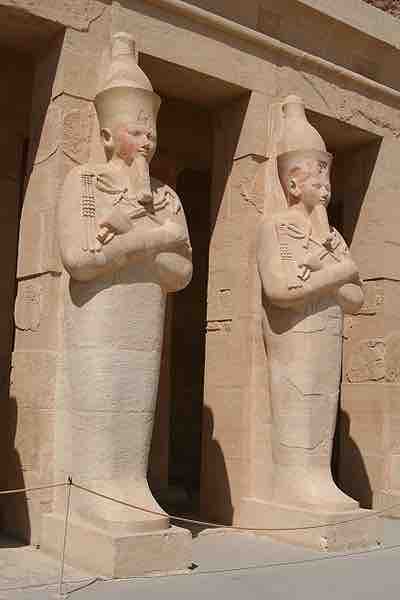Hatshepsut (1508–1458 BC) was the fifth pharaoh of the 18th dynasty of Ancient Egypt. She is generally regarded as one of the most successful pharaohs, reigning for 22 years, longer than any other woman of an indigenous Egyptian dynasty. The earliest attestation to her leadership exists in artifacts found in the tomb of Ramose and Hatnofer.
Women had a high status in ancient Egypt and enjoyed the legal right to own, inherit, or will property. A woman becoming pharaoh was rare, however, with only 3-5 preceding her as ruling solely in their own name. Hatshepsut's reign was very successful, marked by an extended period of peace and wealth-building, trading expeditions and great building projects.
Hatshepsut was one of the most prolific builders in ancient Egypt, commissioning hundreds of construction projects throughout both Upper Egypt and Lower Egypt. She was known for constructing monuments to glorify her own achievements, and her buildings are argued to have been grander and more numerous than those of any of her Middle Kingdom predecessors'. Following the tradition of most pharaohs, Hatshepsut had monuments constructed at the Temple of Karnak. She restored the original Precinct of Mut at Karnak that had been ravaged by the foreign rulers during the Hyksos occupation.
Another project, Karnak's Red Chapel or Chapelle Rouge, was lined with carved stones that depicted significant events in Hatshepsut's life. She had twin obelisks, at the time the tallest in the world, erected at the entrance to the temple. One still stands today as the tallest surviving ancient obelisk in the world; the other has broken and toppled. She later ordered the construction of two more obelisks to celebrate her sixteenth year as pharaoh.
The Temple of Pakhet was built at Beni Hasan, and represented a synthesis of two lioness war goddesses. The cavernous underground temple, cut into the rock cliffs on the eastern side of the Nile, was admired by the Greeks during their occupation of Egypt, who compared the goddess to their hunter goddess, Artemis. The temple has an architrave with a long dedicatory text bearing Hatshepsut's famous denunciation of the Hyksos, who had led Egypt into a cultural decline prior to her rule.
Following the tradition of many pharaohs, the masterpiece of Hatshepsut's building projects was her mortuary temple. The Temple of Hatshepsut was designed and implemented at a site on the West Bank of the Nile River, near the entrance to what now is called the Valley of the Kings, because of all the pharaohs who later chose to associate their complexes with the grandeur of hers. The focal point of the tomb was the Djeser-Djeseru or "the Sublime of Sublimes", a colonnaded structure of perfect harmony that predates the Parthenon by nearly one thousand years. Built into a cliff face, Djeser-Djeseru sits atop a series of terraces that once were graced with lush gardens. Funerary goods belonging to Hatshepsut include a lioness "throne", a game board with carved lioness head, red-jasper game pieces bearing her title as pharaoh, a signet ring, and a partial shabti figurine bearing her name.

Colonnaded design of Hatshepsut temple
Hatshepsut's temple is most famous for its Djeser-Djeseru, a colonnaded structure of such architectural skill, that predates the Parthenon by nearly one thousand years.
Hatshepsut's construction of statues was so prolific that today almost every major museum in the world has a statue of hers among their collections. While some statues show her in typically feminine attire, others depict her in the royal ceremonial attire. The physical aspect of the gender of pharaohs was rarely stressed in the art, and with few exceptions, subjects were idealized. The Osirian statues of Hatshepsut, located at her tomb, follow the Egyptian tradition of depicting the dead pharaoh as the god Osiris . However, many of the official statues commissioned by Hatshepsut show her less symbolically, and more naturally, as a woman in typical dresses of the nobility of her day .

Detail of Hatshepsut, Eighteenth dynasty of Egypt, c. 1473-1458 B.C.
Hatshepsut is depicted in the clothing of a male king, though with a feminine form - differing from the Osirian statues in which she appears much more androgynous.

Osirian statues of Hatshepsut, Temple of Hatshepsut at Luxor
These figures depict her in traditional royal regalia, as was the custom for pharaohs, regardless of gender. One stood at each pillar of the extensive structure of her tomb.
Despite her achievements, an attempt was made to remove Hatshepsut from certain historical and pharaonic records. Amenhotep II (the son of Hatshepsut's heir Tuthmose III) sought to erase her legacy and claim many of her accomplishments as his own. Her cartouches and images were chiselled off some stone walls, leaving very obvious Hatshepsut-shaped gaps in the artwork. While it is clear that much of this rewriting of Hatshepsut's history occurred only during the close of Thutmose III's reign, it is not clear why it happened, other than the typical pattern of self-promotion that existed among the pharaohs and their administrators. Or perhaps, saving money by not building new monuments for the burial of Thutmose III and instead, using the grand structures built by Hatshepsut.
The erasure of Hatshepsut's name—whatever the reason or the person ordering it—almost caused her to disappear from Egypt's archaeological and written records; however, the erasures were sporadic and haphazard, leaving enough for Egyptologists to piece together the history of this great Pharaoh.